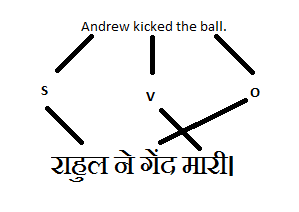Procedure: Participants will be presented with two verbs and an abstract noun: -
LANGUAGE INFLUENCE ON THOUGHT
(Using English - Hindi comparison as a criteria) - SE 367 project proposal
For the past three decades, a lot of philosophers and cognitive researchers have been debating over the issue as to whether the language that we use determines our thoughts, perception, the way we see the world etc. or not. Some of the pioneers in this field were people like Humboldt (1836) (believed that you cannot separate language and thought) and Benjamin Lee Whorf (Founder of the famous school of thought "Whorfianism") to name a few.
A definition about the original version of the Whorfian hypothesis from Wikipedia reads:-
"It is the idea that differences in the way languages encode cultural and cognitive categories, affect the way people think, so that speakers of different languages think and behave differently because of it." [1]
This strong version was rejected after some critical study regarding colour perception and emotion display was done. However a softer version of the hypothesis was then considered.
In simple words, the softer version of the hypothesis claims basically two things:-
1] Languages vary in their view of the world and of abstract entities like time, space etc. which can influence how a person thinks.
2] Semantics/Structure of a language may also influence the way a person perceives the world.
The first claim was demonstrated by a work of Lera Boroditsky [2] wherein she demonstrated how English and Mandarin speakers talk very differently about time. English basically treats time to be horizontal in nature (words like before/after are used to describe events) whereas Mandarin treats it to be vertical (words like shang(up) and xia(down) are used to describe sequence of events). Through a set of experiments, she was able to show that Chinese speakers did think of time to be vertical even when they were using English sentences.
Through this project, my basic aim is to:-
a] Show that language does influence how a person perceives the world (at least the abstract ideas).
b] What influence does the semantics of native language have on the most basic pictorial and sign languages? For doing so I will try to verify the second Whorfian claim regarding semantics through two experiments.
The work by Richardson [5], showed how mental representations of abstract entities like time are formed in us according to the language we use. Moreover, these representations are also formed when we comprehend verbs. The following experiment has been taken from the paper and has been modified to test the same for Hindi.
Participant: Bilingual speakers (Since, there is not much difference in spatial verbs between Hindi and English).
Procedure: Participants will be presented with two verbs and an abstract noun: - For each of these words, they have to pick one or more of the following case.
On a semantic/structural level English and Hindi as a language differ on the fact that English is basically a SVO language and Hindi is a SOV language.
Example: -

This experiment has been adapted from the work of Marieke Schouwstra (CogSci2011) [3]
Participants: - Primarily native Hindi speakers (having no idea of English) and native English speakers (having no idea of Hindi). The range of their age would be 18 - 35 years.
Procedure: - The participants will be given 2 sets of 3 images each. The 3 images of each set will be either related to the subject, object or verb. The participants will then be asked to arrange each set in a logical order.
Sample image sets:-
1)
Participants: - Bilingual adults between 18 - 25 years of age.
Procedure: - Participants will be given a sentence in Hindi and English and their task would be to act it out just as is done in DumbC.
Ex: - English Cue: - I love books.
Hindi Cue: -
Here again if the semantics does play a role then, the participants must act out the line according to the order in the language in which they have been given the input.
[1] http://en.wikipedia.org/wiki/Whorfianism
[2] "Does Language Shape Thought?: Mandarin and English Speakers' Conceptions of Time" - Lera Boroditsky, Cognitive Psychology 43, 1-22 (2001)
[3] "Semantic structure in improvised communication" (CogSci2011) Marieke Schouwstra, ET. al (Anouschka van Leeuwen, Nicky Marien, Marianne Smit, Henriette de Swart)
[4] Language in mind: Advances in the study of language and thought, By Dedre Gentner
[5] Spatial representations activated during real-time comprehension of verbs Daniel C. Richardson, Michael J. Spivey, Lawrence W. Barsalou, Ken McRae
SUMIT VERMA| Y9605 | SE367